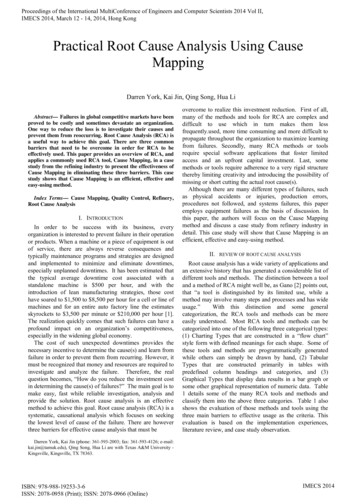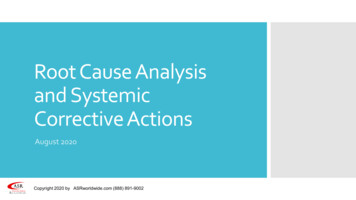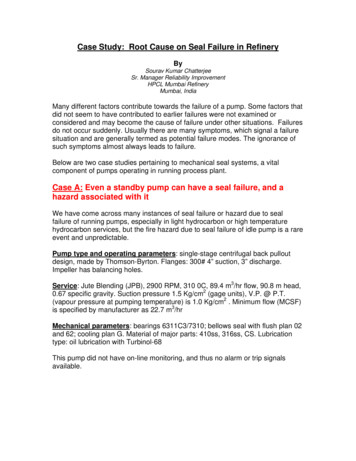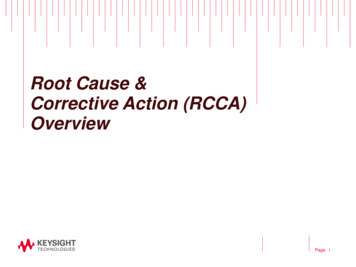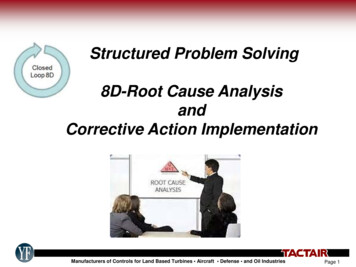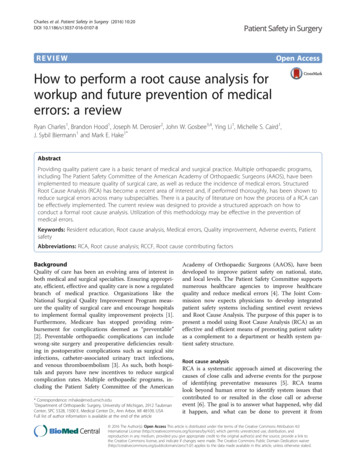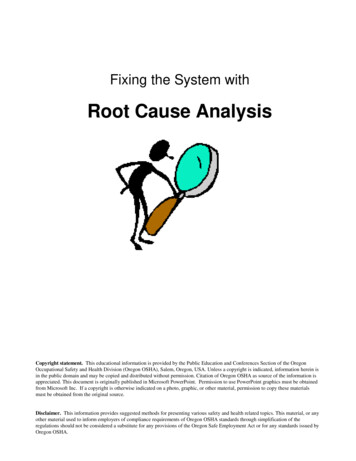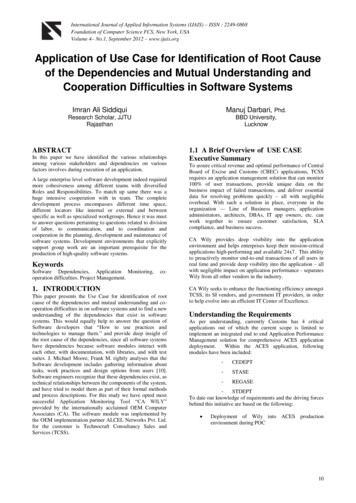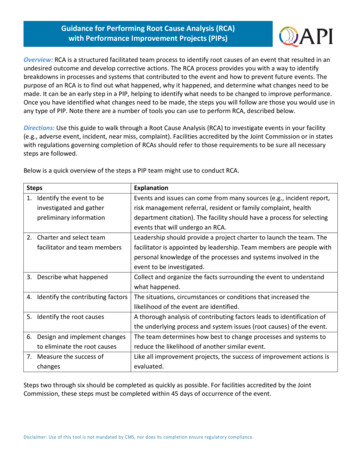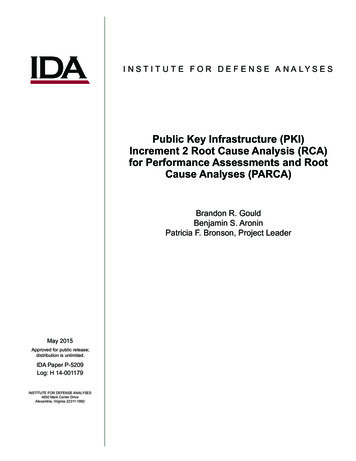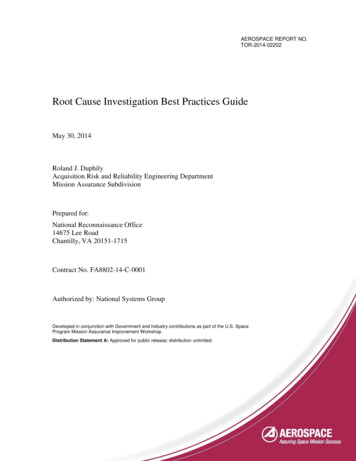
Transcription
AEROSPACE REPORT NO.TOR-2014-02202Root Cause Investigation Best Practices GuideMay 30, 2014Roland J. DuphilyAcquisition Risk and Reliability Engineering DepartmentMission Assurance SubdivisionPrepared for:National Reconnaissance Office14675 Lee RoadChantilly, VA 20151-1715Contract No. FA8802-14-C-0001Authorized by: National Systems GroupDeveloped in conjunction with Government and Industry contributions as part of the U.S. SpaceProgram Mission Assurance Improvement Workshop.Distribution Statement A: Approved for public release; distribution unlimited.
Form ApprovedOMB No. 0704-0188Report Documentation PagePublic reporting burden for the collection of information is estimated to average 1 hour per response, including the time for reviewing instructions, searching existing data sources, gathering andmaintaining the data needed, and completing and reviewing the collection of information. Send comments regarding this burden estimate or any other aspect of this collection of information,including suggestions for reducing this burden, to Washington Headquarters Services, Directorate for Information Operations and Reports, 1215 Jefferson Davis Highway, Suite 1204, ArlingtonVA 22202-4302. Respondents should be aware that notwithstanding any other provision of law, no person shall be subject to a penalty for failing to comply with a collection of information if itdoes not display a currently valid OMB control number.1. REPORT DATE2. REPORT TYPE30 MAY 2014Final3. DATES COVERED-4. TITLE AND SUBTITLE5a. CONTRACT NUMBERRoot Cause Investigation Best Practices GuideFA8802-14-C-00015b. GRANT NUMBER5c. PROGRAM ELEMENT NUMBER6. AUTHOR(S)5d. PROJECT NUMBERRoland J. Duphily5e. TASK NUMBER5f. WORK UNIT NUMBER7. PERFORMING ORGANIZATION NAME(S) AND ADDRESS(ES)The Aerospace Corporation 2310 E. El Segundo Blvd. El Segundo, CA90245-46098. PERFORMING ORGANIZATION REPORTNUMBERTOR-2014-022029. SPONSORING/MONITORING AGENCY NAME(S) AND ADDRESS(ES)10. SPONSOR/MONITOR’S ACRONYM(S)National Reconnaissance Office 14675 Lee Road Chantilly, VA20151-1715NRO11. SPONSOR/MONITOR’S REPORTNUMBER(S)12. DISTRIBUTION/AVAILABILITY STATEMENTApproved for public release, distribution unlimited13. SUPPLEMENTARY NOTESThe original document contains color images.14. ABSTRACT15. SUBJECT TERMS16. SECURITY CLASSIFICATION OF:a. REPORTb. ABSTRACTc. THIS PAGEunclassifiedunclassifiedunclassified17. LIMITATIONOF ABSTRACT18. NUMBEROF PAGESUU11019a. NAME OFRESPONSIBLE PERSONStandard Form 298 (Rev. 8-98)Prescribed by ANSI Std Z39-18
Executive SummaryThis guide has been prepared to help determine what methods and software tools are available whensignificant detailed root cause investigations are needed and what level of rigor is appropriate toreduce the likelihood of missing true root causes identification. For this report a root cause is theultimate cause or causes that, if eliminated, would have prevented recurrence of the failure. In reality,many failures require only one or two investigators to identify root causes and do not demand aninvestigation plan that includes many of the practices defined in this document.During ground testing and on-orbit operations of space systems, programs have experiencedanomalies and failures where investigations did not truly establish definitive root causes. This hasresulted in unidentified residual risk for future missions. Some reasons the team observed for missingthe true root cause include the following:1. Incorrect team composition: The lead investigator doesn’t understand how to perform anindependent investigation and doesn’t have the right expertise on the team. Many timesspecialty representatives, such as parts, materials, and processes people are not part of theteam from the beginning. (Sec 5.3)2. Incorrect data classification: Investigation based on assumptions rather than objectiveevidence. Need to classify data accurately relative to observed facts (Sec 6.1)3. Lack of objectivity/incorrect problem definition: The team begins the investigation with alikely root cause and looks for evidence to validate it, rather than collecting all of thepertinent data and coming to an objective root cause. The lead investigator may be biasedtoward a particular root cause and exerts their influence on the rest of the team members.(Sec 7)4. Cost and schedule constraints: A limited investigation takes place in the interest ofminimizing impacts to cost and schedule. Typically the limited investigation involvesarriving at most likely root cause by examining test data and not attempting to replicate thefailed condition. The actual root cause may lead to a redesign which becomes too painful tocorrect.5. Rush to judgment: The investigation is closed before all potential causes are investigated.Only when the failure reoccurs is the original root cause questioned. “Jumping” to a probablecause is a major pitfall in root cause analysis (RCA).6. Lack of management commitment: The lead investigator and team members are not givenmanagement backing to pursue root cause; quick closure is emphasized in the interest ofprogram execution.7. Lack of insight: Sometimes the team just doesn’t get the inspiration that leads to resolution.This can be after extensive investigation, but at some point there is just nothing else to do.The investigation to determine root causes begins with containment, then continues with preservationof scene of failure, identifying an anomaly investigation lead, a preliminary investigation, anappropriate investigation team composition, failure definition, collection/analysis of data availablebefore the failure, establishing a timeline of events, selecting the root cause analysis methods to useand any software tools to help the process.This guide focuses on the early actions associated with the broader Root Cause Corrective Action(RCCA) process. The focus here includes the step beginning with the failure and ending with the rootcause analysis step. It is also based on the RCI teams’ experience with space vehicle related failuresi
on the ground as well as on-orbit operations. Although many of the methods discussed are applicableto ground and on-orbit failures, we discuss the additional challenges associated with on-orbit failures.Subsequent corrective action processes are not a part of this guide. Beginning with a confirmedsignificant anomaly we discuss the investigation team structure, what determines a good problemdefinition, several techniques available for the collection and classification of data, guidance for theanomaly investigation team on root cause analysis rigor needed, methods, software tools and alsoknow when they have identified and confirmed the root cause or causes.ii
AcknowledgmentsDevelopment of the Root Cause Investigation Best Practices Guide resulted from the efforts of the2014 Mission Assurance Improvement Workshop (MAIW) Root Cause Investigation (RCI) topicteam. Significant technical inputs, knowledge sharing, and disclosure were provided by all membersof the team to leverage the industrial base to the maximum extent possible. For their contentcontributions, we thank the following contributing authors for making this collaborative effortpossible:Harold Harder (Co-Lead)Roland Duphily (Co-Lead)Rodney MoreheadJoe HamanHelen GjerdeSusanne DuboisThomas StoutDavid WardThomas ReinselJim LomanEric LauThe Boeing CompanyThe Aerospace CorporationThe Aerospace CorporationBall Aerospace & Technologies CorporationLockheed Martin CorporationNorthrop Grumman CorporationNorthrop Grumman CorporationOrbital Sciences CorporationRaytheon Space and Airborne SystemsSSLSSLA special thank you goes to Harold Harder, The Boeing Company, for co-leading this team, and toAndrew King, The Boeing Company, for sponsoring this team. Your efforts to ensure thecompleteness and quality of this document are appreciated.The Topic Team would like to acknowledge the contributions and feedback from the followingsubject matter experts who reviewed the document:Lane SaechaoTom HechtMatthew EbyDavid EckhardtGerald SchumannMark WrothDavid AdcockMauricio TapiaAerojet RocketdyneThe Aerospace CorporationThe Aerospace CorporationBAE SystemsNASANorthrop Grumman CorporationOrbital Sciences CorporationOrbital Sciences Corporationiii
Release NotesAlthough there are many failure investigation studies available, there is a smaller sample of groundrelated failure reports or on-orbit mishap reports where the implemented corrective action did noteliminate the problem and it occurred again. Our case study addresses a recurring failure where thetrue root causes were not identified during the first event.iv
Table of Contents1.Overview . 11.1MAIW RCI Team Formation . 12.Purpose and Scope . 23.Definitions . 44.RCA Key Early Actions . 74.1Preliminary Investigation. 74.2Scene Preservation and Data Collection . 84.2.1Site Safety and Initial Data Collection . 84.2.2Witness Statements . 94.2.3Physical Control of Evidence . 104.3Investigation Team Composition and Facilitation Techniques. 114.3.1Team Composition . 114.3.2Team Facilitation Techniques . 125.Collect and Classify Data . 155.1KNOT Chart . 175.2Event Timeline. 175.3Process Mapping . 186.Problem Definition . 207.Root Cause Analysis (RCA) Methods . 227.1RCA Rigor Based on Significance of Anomaly . 227.2Brainstorming Potential Causes/Contributing Factors. 267.3Fishbone Style . 267.4Tree Techniques. 287.4.15-Why’s . 287.4.2Cause Mapping. 297.4.3Advanced Cause and Effect Analysis (ACEA) . 307.4.4Fault Tree Analysis (FTA) . 327.5Process Flow Style . 347.5.1Process Classification. 347.5.2Process Analysis. 357.6RCA Stacking . 368.Root Cause Analysis Tools (Software Package Survey) . 388.1Surveyed Candidates . 388.2Reality Charting (Apollo) . 398.3TapRooT . 408.4GoldFire . 438.5RCAT (NASA Tool). 458.6Think Reliability . 479.When is RCA Depth Sufficient . 499.1Prioritization Techniques . 519.1.1Risk Cube . 519.1.2Solution Evaluation Template . 5210.RCA On-Orbit versus On-Ground .
30.05.2014 · Root Cause Investigation Best Practices Guide . May 30, 2014 . Roland J. Duphily . Acquisition Risk and Reliability Engineering Department Mission Assurance Subdivision . Prepared for: National Reconnaissance Office 14675 Lee Road Chantilly, VA 20151-1715 . Contract No. FA8802-14-C-0001 . Authorized by: National Systems Group . Developed in conjunction with Government and
